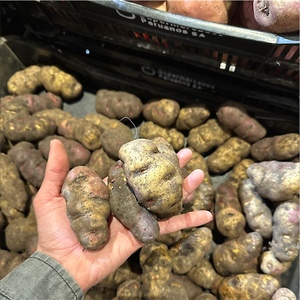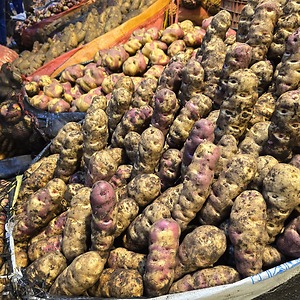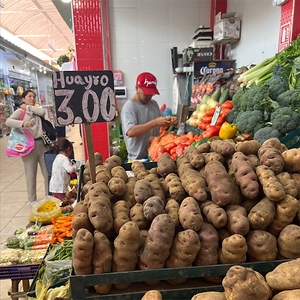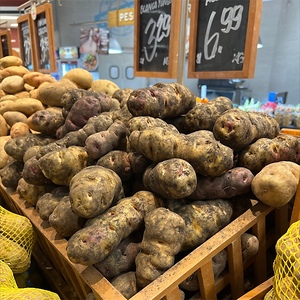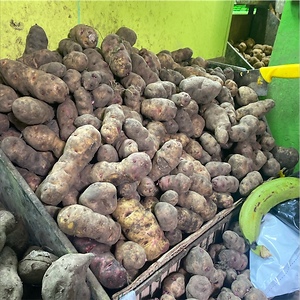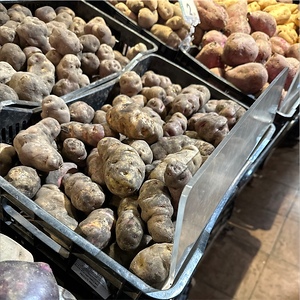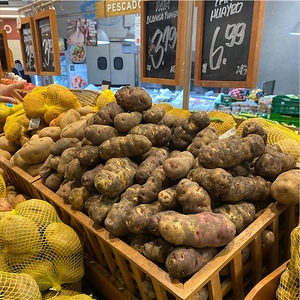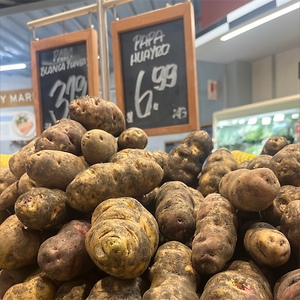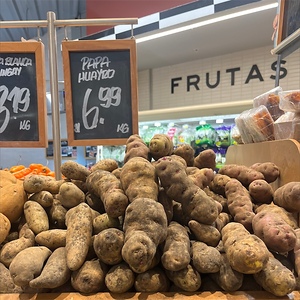


Huayro Potatoes
Estimated Inventory, lb : 0
Description/Taste
Huayro potatoes vary in size and shape, depending on growing conditions and the specific variety. The tubers generally sold in commercial markets average 8 to 14 centimeters in length and 4 to 6 centimeters in diameter and have an elongated, cylindrical, or oblong shape with blunt, curved ends. Huayro potatoes are covered in prominent, deep-set eyes, and these eyes create indentations on the surface, giving the tubers a knobby, lumpy appearance. The potatoes are often sold still covered in soil, giving them a dark brown, black, to grey coloring. Once cleaned, the skin typically showcases brown to golden brown hues with red, maroon, and purple accents. The skin is semi-thin, smooth, lightly textured, and taut. Underneath the surface, the golden flesh is dense, firm, and slippery when raw, softening to a grainy, semi-firm, tender, and floury texture when cooked. Some types of Huayro grown in the Andes Mountains showcase pigmented hues within the flesh, while others have a solid yellow coloring. Huayro potatoes are edible once cooked and have a mild, neutral, savory, and earthy flavor.
Seasons/Availability
Huayro potatoes are available year-round.
Current Facts
Huayro potatoes, botanically classified as Solanum tuberosum, are a Peruvian variety belonging to the Solanaceae or nightshade family. The tubers are a type of native potato, also known as papa nativa, and have been traditionally cultivated throughout high-elevation regions of the Andes Mountains in Peru. It is important to note that there are many types of Huayro potatoes that vary in size, coloring, and appearance. In regional markets, Huayro potatoes can be seen under the names Huayro Negro, Huayro Blanco, Huayro Amarillo, Huayro Moro, and Huayro Macho. There are also several indigenous names used in various communities within the Andes. Huayro potatoes, as an overall category, are favored for their floury nature, allowing them to develop a texture that somewhat holds its shape and also absorbs accompanying flavors without falling apart. The variety was recently selected as a native tuber to be promoted commercially as a part of Peru’s ongoing movement to increase awareness surrounding native potatoes. Huayro potatoes are widely seen stacked in large piles throughout local markets in cities such as Lima, and the variety is also sold throughout rural communities in the Andes Mountains. Since its selection as a commercial tuber, Huayro potatoes are advertised as an everyday variety that can be used for more traditional recipes as well as modern fusion dishes. The tubers have a mild, subtly sweet, and earthy taste and can be incorporated into a wide array of savory culinary preparations.
Nutritional Value
Huayro potatoes have not been extensively studied for their nutritional properties. Like other native potato varieties, the tubers may be a source of potassium to balance fluid levels within the body, vitamin C to strengthen the immune system, and fiber to regulate the digestive tract. Potatoes, in general, also provide iron to develop the protein hemoglobin for oxygen transport through the bloodstream, phosphorus to repair tissues, calcium to protect bones and teeth, and other nutrients, including magnesium, manganese, zinc, and folate.
Applications
Huayro potatoes have an earthy, subtly sweet, and neutral taste suited for cooked preparations. The variety is known for its ability to develop a light, fluffy consistency while also absorbing accompanying flavors. Huayro potatoes are popularly simmered into soups, chowders, braises, and stews or boiled and served as a simple side dish to roasted meats. The tubers can also be cooked and mashed, made into fries, or boiled and served with hot sauce. In Peru, Huayro potatoes are often cooked in earthen ovens in the Andes Mountains in preparations known as huatia and pachamanca. The tubers are also layered in causa, mashed and stuffed into papa rellena, or used in ocopa, a dish of boiled potatoes covered in a fragrant huacatay sauce. Huayro potatoes are sometimes cooked as a side dish to anticuchos or deep fried and eaten with pork in chicharrones. Huayro potatoes pair well with black olives, corn, tomatoes, aromatics such as aji amarillo, onions, and garlic, spices including cumin, paprika, and cloves, smoked bacon, fish, beef, and poultry. Whole, unwashed Huayro potatoes will keep for several months when stored in a cool, dry, and dark location.
Ethnic/Cultural Info
Huayro potatoes are considered one of the best native potato varieties for making the dish papa a la Huancaína in Peru. There are many theories as to the origins of this recipe, but the most shared stories date back to the late 19th century when the Central Railway was being built between Lima and Huancayo. It is believed that groups of women from Huancayo would carry food to the workers constructing the railway in remote areas. Legend has it that one of the women prepared a dish of sliced potatoes covered in a cheese sauce. This dish became a favorite meal among the workers, and people began asking when the Huancayo lady was arriving with her potatoes. This is the rumored meaning behind the dish's name, as papa a la Huancaína roughly translates from Spanish to mean “potatoes in the style of the Huancayo woman.” There is also another prevalent story pointing to the origins of the dish arising from a woman named Paguantanta, who would sell the potatoes on the train as it was traveling to and from Huancayo. Regardless of which story is the true origin of the dish, papa a la Huancaína quickly increased in popularity throughout the late 19th century and became a favored appetizer to other traditional Peruvian meals. Historically, the dish was made with potatoes in a crumbled cheese sauce made with rocoto, but it evolved and later substituted rocoto for aji amarillo to give the sauce its signature yellow hue. Papa a la Huancaína is customarily garnished with olives, lettuce, and hardboiled eggs. Huayro potatoes are used in this dish as the tubers can hold their shape when cooked but also readily absorb accompanying flavors, showcasing the fragrant spices of the sauce.
Geography/History
Huayro potatoes are native to South America and are descendants of wild varieties that grew naturally throughout the highlands of the Andes mountains. Much of the history of the variety is unknown, as little written records were left before the arrival of the Spanish, but it is believed that Huayro potatoes are a type of native potato that has traditionally been grown through small farms and family plots for centuries. Potatoes, in general, are thought to have been first domesticated over 10,000 years ago in the Andes mountains, and the oldest archeological findings were sourced from areas around Lake Titicaca. Over time, potatoes were selectively bred for improved flavor, texture, and cultivation characteristics, eventually becoming one of the most essential crops within the Andes. Huayro potatoes have remained a favored native variety, and many types found throughout Peru are grouped under the general Huayro name. Around the 20th century, Huayro was selected to become a commercially produced crop for increased cultivation and sales to help Andean farmers generate higher income. The variety is often promoted through native potato exhibitions and events. Today, Huayro potatoes are grown throughout Peru, including regions such as Pasco, Huancayo, Cusco, Apurímac, Huancavelica, and Huánuco, and are shipped across the country for sale in local markets and commercial supermarkets. The Huayro potatoes featured in the photograph above were sourced through markets in Lima, Peru.
Recipe Ideas
Recipes that include Huayro Potatoes. One
| Lidija's Kitchen |
|
Octopus with Aji Amarillo Potatoe |



